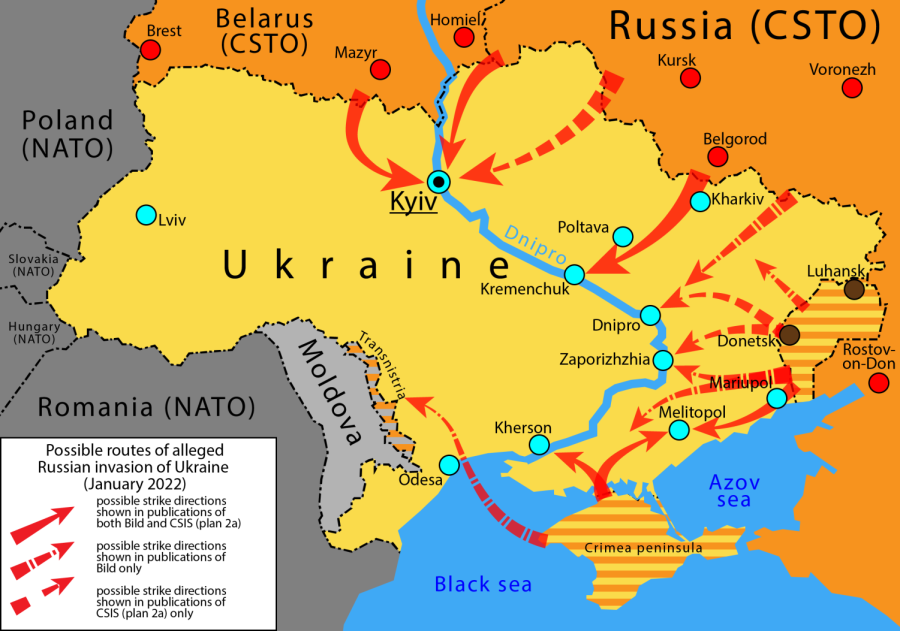Putin Continues With Attacks Against Ukraine
A map of Ukraine uses red arrows and bullet points to show where Putin is targeting. Most attacks come from the East end of the country as it borders Russia.
March 14, 2022
“I have made the decision to carry out a special military operation,” declared Russian president Vladimir Putin on Feb. 24. What followed this address has been nuclear threats, a continuance of attacks on Ukraine, and an interrupted evacuation of the Ukrainian people due to Russian shelling.
As war looms, fear for Ukrainian safety becomes an international concern. The invasion also calls people to worry for the individuals under the Russian government who are voicing their dissent about the attacks publicly–despite the proposed consequences of denying censorship.
“I am just more concerned about the friends and people that we know there [Ukraine] and I am also worried about the people in Russia who are protesting it because it’s a dictatorship. Putin is not going to stand for that,” said senior and Russian-speaking Ukrainian, Isabella Poppen.
All fronts of Ukraine are currently being bombarded with Russian tanks, and major cities are under fire. Over 1.2 million Ukranians refugees have fled the country whilst the rest remain in hiding, continue attempts to escape, or are one of the hundreds of casualties the invasion has caused.
In Putin’s desire to redraw the European map, he has spared no expense, with intense force being put upon Ukrainian citizens as he continues to declare Ukraine and Russia as “one nation.” Ukraine, which shares borders with both Russia and the European Union, is in the middle of membering countries in NATO whilst the other side of the perimeter is specifically targeted for Russian invasion.
As one of the founders of NATO–The North Atlantic Treaty Organization–The United States is to work as a united front with its membering countries, providing support if endangered by another. Although Ukraine is not part of NATO, the organization has come together in support of the country.
In a recent address by Jens Stoltenberg, NATO Secretary General, it was announced that the allying members would not have NATO planes over Ukrainian airspace in an effort to decrease the possibility of a global war. As far as land space goes, however, the Ukrainian government has announced that over 16,000 foreign soldiers have come to help within Ukrainian borders.
“When [the armed forces] see rights being infringed on Ukraine they think they should do something,” said senior Eric Sills who joined the U.S. Navy last summer.
As of today, the exact instruction of U.S. forces is an uncertain feat. Soldiers around the country are being dispatched to Ukraine by the day, an additional 500 U.S. troops having been sent to Europe as of March 7th.
It is reported by U.S. forces that there may be up to 4000 Russian soldier casualties within Ukraine, with an indication of 670 Russian missiles being shot out since the invasion began.
This attack is no sudden circumstance, with threats and division between Ukraine and Russia beginning long before Putin’s address in February. Whilst the world waits and retains hope for Ukraine and its future, individuals may donate to fundraisers including “Stand With Ukraine,” which correlates with the Emergency Response Fund in an immediate focus to send medical and tactical supplies to Ukrainian locations in need.



